
Trentino-Alto Adige/Südtirol is an autonomous region of Italy, located in the northern part of the country. The region has a population of 1.1 million, of whom 62% speak Italian as their mother tongue, 30% speak South Tyrolean German and several foreign languages are spoken by immigrant communities. Since the 1970s, most legislative and administrative powers have been transferred to the two self-governing provinces that make up the region: the province of Trento, commonly known as Trentino, and the province of Bolzano, commonly known as South Tyrol. In South Tyrol, German remains the sizeable majority language.
Schwandorf is a Landkreis (district) in Upper Palatinate in the eastern part of Bavaria, Germany. Neighboring districts are Cham, Regensburg, Neumarkt, Amberg-Sulzbach, Neustadt an der Waldnaab, and the Czech Plzeň Region.

Mòcheno is an Upper German variety spoken in three towns of the Bersntol, in Trentino, northeastern Italy.

The University of Bern is a public research university in the Swiss capital of Bern. It was founded in 1834. It is regulated and financed by the Canton of Bern. It is a comprehensive university offering a broad choice of courses and programs in eight faculties and some 150 institutes. With around 19,000 students, the University of Bern is the third largest university in Switzerland.

Valentino Braitenberg was an Italian neuroscientist and cyberneticist. He was a former director at the Max Planck Institute for Biological Cybernetics in Tübingen, Germany.

Kastelruth is a comune (municipality) and a village in South Tyrol in northern Italy, about 20 kilometres (12 mi) northeast of the city of Bolzano. It is one of I Borghi più belli d'Italia.

Graun im Vinschgau is a comune (municipality) and a village in South Tyrol in northern Italy, located about 70 kilometres (43 mi) northwest of Bolzano, on the border with Austria and Switzerland.

Villnöß is a comune (municipality) in South Tyrol in northern Italy, located about 30 kilometres (19 mi) northeast of the city of Bolzano.
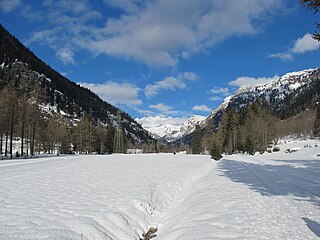
Formazza is a comune (municipality) in the Province of Verbano-Cusio-Ossola in the Italian region Piedmont, located about 160 kilometres (99 mi) northeast of Turin and about 50 kilometres (31 mi) north of Verbania, on the border with Switzerland.
Franz Friedrich Kohl was an Austrian entomologist and folksong researcher.

Tyrol Castle, less commonly Tirol Castle is a castle in the comune (municipality) of Tirol near Merano, in the Burggrafenamt district of South Tyrol, Italy. It was the ancestral seat of the Counts of Tyrol and gave the whole Tyrol region its name.
The Haidersee is a lake in South Tyrol, Italy, which belongs to the municipality of Graun im Vinschgau.
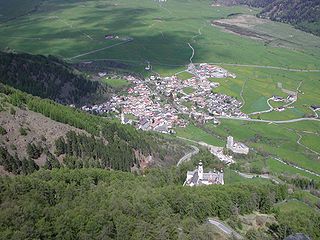
Burgeis is the largest frazione of the comune of Mals, Italy, and sits at an altitude of 1216m in Vinschgau in South Tyrol beneath the mountain Watles (2557) on the upper reaches of the Adige. The name goes all the way back to a Roman founding, as a fort on the "Via Claudia Augusta", which runs through the village. This fort later gave the name of the Edelfreien von Burgus-Wanga, whose arms the village bears today.
San Valentino can refer to Saint Valentine, ancient Roman saint.
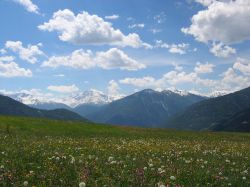
The Mals Heath is located in South Tyrol, Italy; it is one of the largest ancient landslides and one of the most remarkable landscape features in the Alps. It is located in the Upper Vinschgau where a broad pass crosses the main Alpine divide into the Inn Valley (Austria). It extends from Glurns via Laatsch, Schleis, and Burgeis up to Plawenn. On the southern part is the village of Mals. The height difference of the heath varies from 900 m (Glurns) to 1,760 m. The landslide emerges from the small side valley of Plawenntal, and descends for 11 km to the head of Vinschgau proper. The volume of the debris fan is estimated at 1,650 million cubic metres. It had always been assumed to be an alluvial fan, built up by numerous floods and debris small flows. New research demonstrates that a lost mountain could have existed above the head of Plawenntal, with a summit at about 3,100m - the present highest peak on the perimeter being the Mittereck, 2,908 m. There are indications all around the perimeter of a catastrophic collapse, severing former ridges and valley heads. The shape of the lost mountain can readily be reconstructed by projecting these truncated landforms until they meet up. The volume of the lost mountain is very close to that of Mals Heath. There is at present no evidence of when this event occurred, but probably soon after the last glacier melted, over 10,000 years ago. Similar events probably created large fans nearby at St. Valentin, and in the main Vinschgau, notably at Allitz-Laas (Gadriamure) where the lost mountain and vast debris cone are even larger. Other megafans in the Alps are likely to be catastrophic too (1). The Mals Heath used to be a barren heath since it was so free draining. The debris fan dams a lake, Haidersee, which is now used as a source of irrigation water through a system of channels, and nearly all the heath is now cultivated and prosperous. The fan also displaces the main river, Adige, and the large tributary, Puni, to opposite sides of the valley. Disastrous floods still occur, destroying houses and even villages. The main road climbs the fan in broad zigzags, not the usual hairpins of an alpine pass, with several large wind turbines taking advantage of the smooth terrain and natural wind funnel.

Reinhold Stecher was an Austrian Prelate of the Roman Catholic Church.
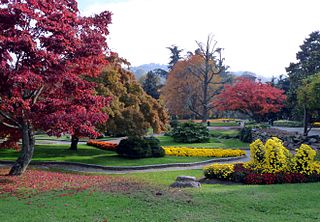
Parco del Valentino is a popular public park in Turin, Italy. It is located along the west bank of the Po river. It covers an area of 500,000m², which makes it Turin's second largest park . This park has been nominated “The best Italian park” after a selection among the fifteen best Italian parks.
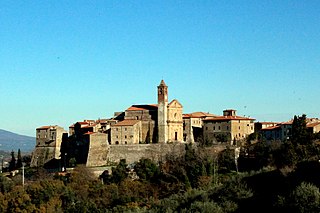
Caldana is a village in Tuscany, central Italy, administratively a frazione of the comune of Gavorrano, province of Grosseto. At the time of the 2001 census its population amounted to 980.

Johann Siegmund Valentin Popowitsch was a Styrian philologist and natural scientist. His advocacy of a standardized Upper German paved the way for Austrian German as a variety of Standard German.
The 30th Venice Biennale, held in 1960, was an exhibition of international contemporary art, with 34 participating nations. The Venice Biennale takes place biennially in Venice, Italy. Winners of the Gran Premi included French painter Jean Fautrier, German painter Hans Hartung, Italian painter Emilio Vedova, and Italian sculptor Pietro Consagra.















